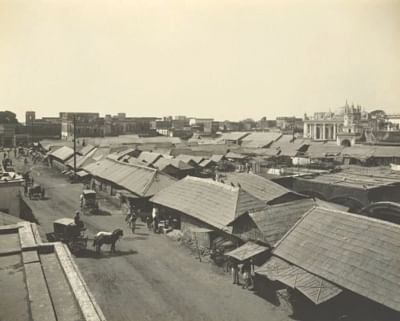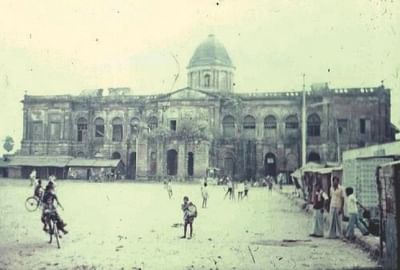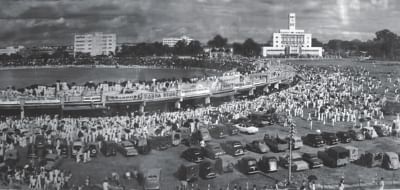| Home - Back Issues - The Team - Contact Us |
 |
| Volume 11 |Issue 34| August 31, 2012 | |
|
|
Perceptions Once Upon a Time in Dacca Syed MaqsudJamil The South Asian subcontinent has seen the creation of two countries - India and Pakistan. For its part Pakistan had two parts, the larger western part and the smaller and populous eastern part. Dacca, as it was known then, was the capital of the eastern part. It was a small provincial town of two and a half hundred thousand people. The population was predominantly of the original Muslims inhabitants of the town. They were the Dhakaites. There were white collar government officials, landed gentry with their mansions and buildings, politicians with newly developing plumage, smattering of businessman and professionals. There was a declining Hindu community. They had nothing to identify with Pakistan.
The Dhakaites had their own customs and culture. They were broadly defined along three lines; the Nawab family, the Sukhbas (the comfortably placed) and the Kuttis (the ordinary people). For the Nawabs the language was Urdu, not exactly of Lucknow. The Sukhbas also talked in Urdu in their house, but the language was of their own kind. Many of the Kuttis spoke a highly bengalicised Urdu while the others spoke a special dialect of Bengali that still mark them out. The Eid festival has just ended. There were no jazzy shopping malls then, yet Ramadan and Eid brought out the best of fervour and joy from the Dhakaites and the people of Dacca. During Ramadan Qasida (Urdu couplets composed and sung to awaken the faithful for Sehri) competition was held. It was organised by Mirza Abdul Kader, the proprietor of Lion cinema and the head of the 22 Sardars (chieftains) of Dacca. The Sardars of Dacca took special interest in it. The best among the Qasida composers and singers were honoured with an attractive cash reward. Most people knew Akram. He had a mellifluous voice. The faithful could not ignore him to get up from bed for sehri. Children were curious to find out how Akram looks. He appeared on Eid day with an aluminium bucket and visited houses. The Eidees dropped into the bucket with great munificence. It was the custom at that time for every house to send iftar to the local mosque. The faithful used to sit around a dastarkhan (long stretch of white linen to partake of the iftar items). When a child in the family was fasting for the first time, it was a special occasion. The iftar sent to the mosque was special. On the first two days of Eid a mela (fair) was held at Chawk Bazar. It was a special attraction for the children, particularly toy items like a two-wheel carriage with a drum set in the middle and two bamboo sticks beating on it as the carriage was dragged along. There was another item--a toy motor launch with kerosene in it, when put in a basin of water it used to circle around with a sputtering sound. The children used to call it bhotbhoti.
Qawali and to a lesser extent sher-shairis were the cultural pastime of Dacca. Qawali was patronised by the elite of Dacca. The patrons and the enthusiasts showered the Qawals for every effusion of love for the Prophet (PBUM) with bountiful cash encouragement. Sher-shairi was popular with the Nawab family and the upcountry residents. And the 30th of Poush was Poush Sangkranti, the day of kite flying. The flamboyant kite flyers gathered at Maidans or on the roof top with the colourful ghuddis (kites) and impressive natais (the wheels). The notables turned out in white kurta and lungi with red vest inside and a golden chain dangling from the neck. They were watched with awe. They used the most expensive tough yarn of 'Hazar gazi' brand. And the lesser ones used the medium priced belcha (spade) brand. The sky of Dacca was littered with flying kites. Another occasion was the circumcision of the boys and kan chedais (piercing the ear lobes) of the girls. The boys and girls were sent for a ride of the town in an open horse-driven carriage. The Hazzam (the one who severed the foreskin) was given a lungi, one and a quarter kilo rice handful of turmeric and Rs 10 on a bamboo tray draped with a red coverlet and the matronly lady who performed the kan chedai was given a saree and some other item. Onlookers asked “kaunbari ka” (from which house)?
When marriage proposal was sent for a lady of Sukhbas family, the family that proposed sent sweet meats and other traditional food items by a train of carriers, the items draped with silk coverlet. Onlookers talked that 'shadi ka paigam jaa raha' (a marriage proposal is on the way). The visiting family members scanned the grace of the lady with observant attention, like how long were her tresses, how even were the set of teeth, how the eyes were set, how slender were the hands and how elegant was the gait of the lady etc. It was a rigorous trial. The bride's family responded with raunchy description of the members of the bridegroom's family. The barbs were launched mostly at the eldest and the youngest sister and of all at the father-in-law with a big paunch. The lady that shed tears on the shoulder of her father during vidayee (farewell) was once the ladli, the darling of the house. That was the age of innocence she was a tender flower in bloom, giggling to fill the house with happiness. There were no cares to clutter her mind. It was an age of guria ki shadi (wedding of the doll), jhutmut ki khana pakana (mock preparation of food). Childhood is a roller coaster drive. One quarrel and there is katti fuming and sulking--the dolls were taken back. But friendship smiled, when the sun came out of the clouds, and life went by once upon a time in Dacca.
Copyright
(R) thedailystar.net 2012 |


